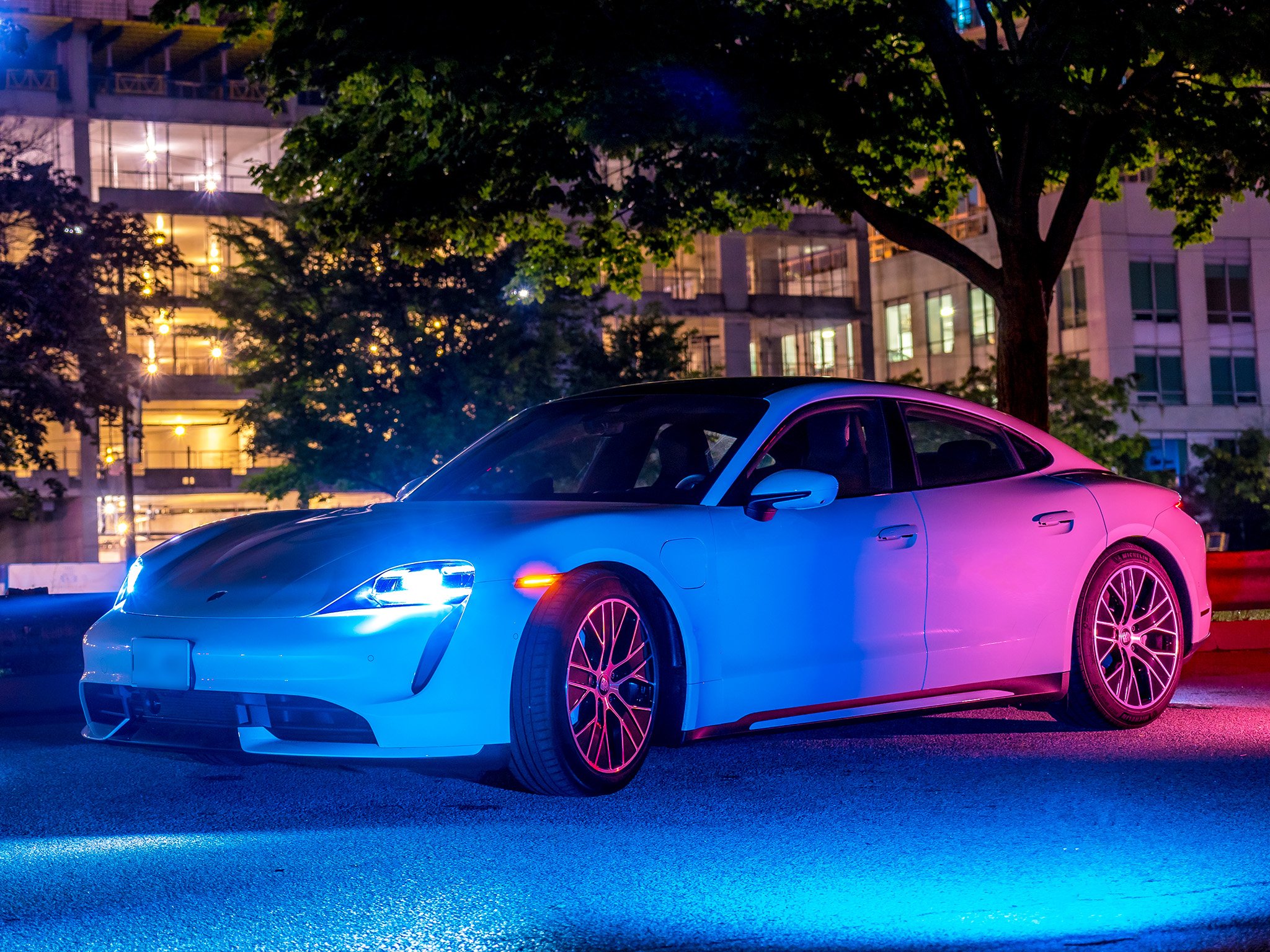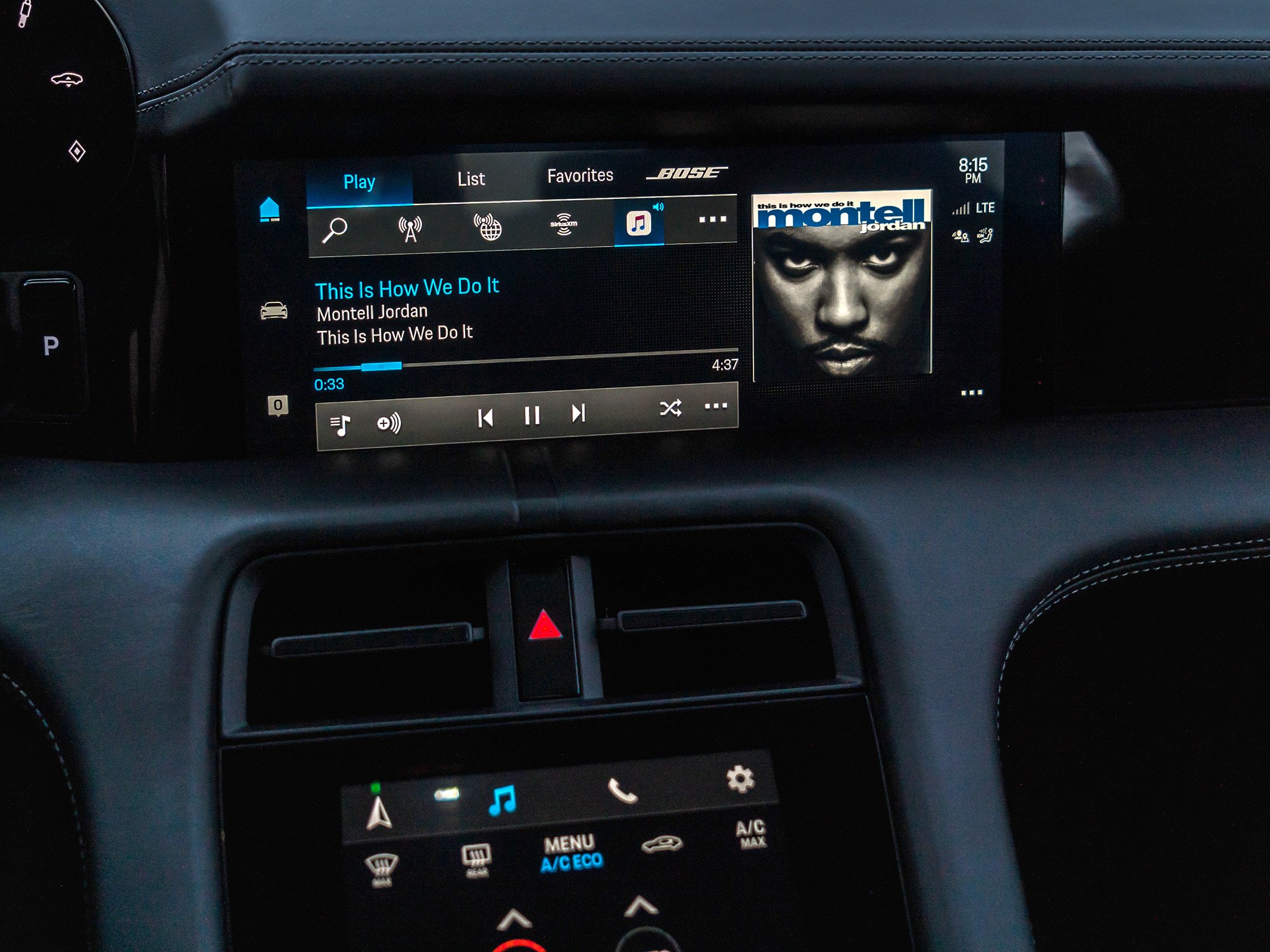iMore Verdict
Bottom line: Apple chooses Porsche as the first luxury car brand to offer drivers a built-in Apple Music streaming experience independent of CarPlay. You will eventually have to pay to stream, but the data is on Porsche's dime. It's a sweet deal up front, but this marriage of convenience isn't always convenient.
Pros
- +
Nice layout
- +
Free streaming data for 3 years
- +
Extra 3 months free for Apple Music
- +
Add songs from radio
- +
You can still use CarPlay
- +
All USB-C ports
Cons
- -
Voice Pilot needs work
- -
Siri is mostly silent
- -
Keyboard works while driving
- -
Passenger display costs extra
You can always trust iMore.
When Porsche unveiled its first all-electric vehicle in the Taycan in 2019, it also came with another debut: the first car to offer built-in access for Apple Music.
The partnership between Apple and Porsche came to light during an event in Atlanta last year at the latter's testing facility in Atlanta. On the face of it, it was a unique value proposition — stream music without needing your phone or your phone's data connection.
Now that the 2020 Taycan is out on the market, reality can set in. For a vehicle that can run you between $100,000 to $240,000, getting some free streaming seems almost par for the course. But how well does it work? I drove it around for a week to find out.
How it all works
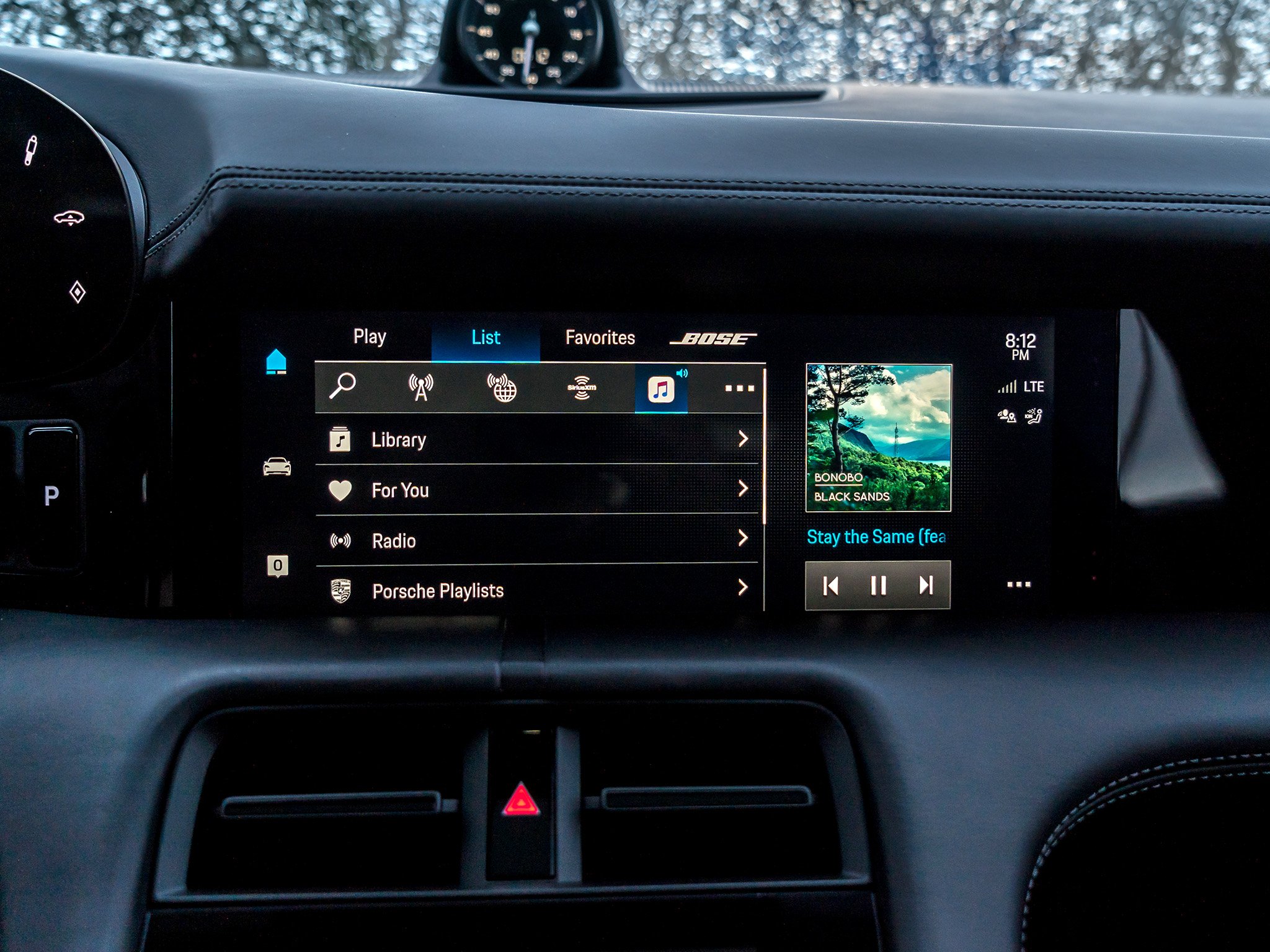
There are some key pieces that are needed to make this integration work. First, Porsche has a SIM card inside running off Verizon's network to provide the free data. Well, it's free for the first three years, with subscription pricing thereafter yet to be confirmed. Taycan drivers also get three months of free trial access to Apple Music, which they can use over and above the three months Apple already offers to new customers. So altogether, you could potentially get six months of Apple Music without dropping a penny.
The other suite of Connect services in the vehicle, like weather, news, online radio, traffic and the battery charging planner, also use the free 3-year data plan, regardless of whether you use Apple Music or not.
It's also totally separate from CarPlay. You can run that in the Taycan when you plug in your iPhone, which I'll touch on later. Then there's Siri, which also sits in the proverbial back seat. Porsche's Communication Management (PCM) takes precedence at all times, and that includes its own Voice Pilot. When you want to find music by voice on the integrated Apple Music, you won't be asking Siri for it.
It's also totally separate from CarPlay.
You also have to create a Porsche ID through the Porsche Connect app (free in the App Store), which gets tied to your Apple ID once you initialize the streaming service in the car for the first time. In my case, IDs for both were already set up for me, so I only went through the last stage of confirming the marriage between them.
Since the Porsche-Apple IDs are tied together one-to-one, bringing in a second one requires setting up different user profiles in the car. For example, if you add a passenger's Porsche ID to the onboard list, they can tie it to their own Apple ID. That way, when you switch profiles, the other Apple Music account appears onscreen. Mind you, it only works with single users, though, not family accounts.
While the Taycan has Wi-Fi capability courtesy of the onboard SIM, it's currently only for connecting the iPhone to the PCM for the calendar functionality. I looked for a hotspot feature in the settings and found nothing. The data connection for supported music streaming is separate from that.
There is also an optional upgrade that includes an extra display facing the front passenger, who can use it to navigate Apple Music and other playback controls in the PCM system. Unfortunately, my test drive model didn't have it, so couldn't assess how useful it is.
Playing music
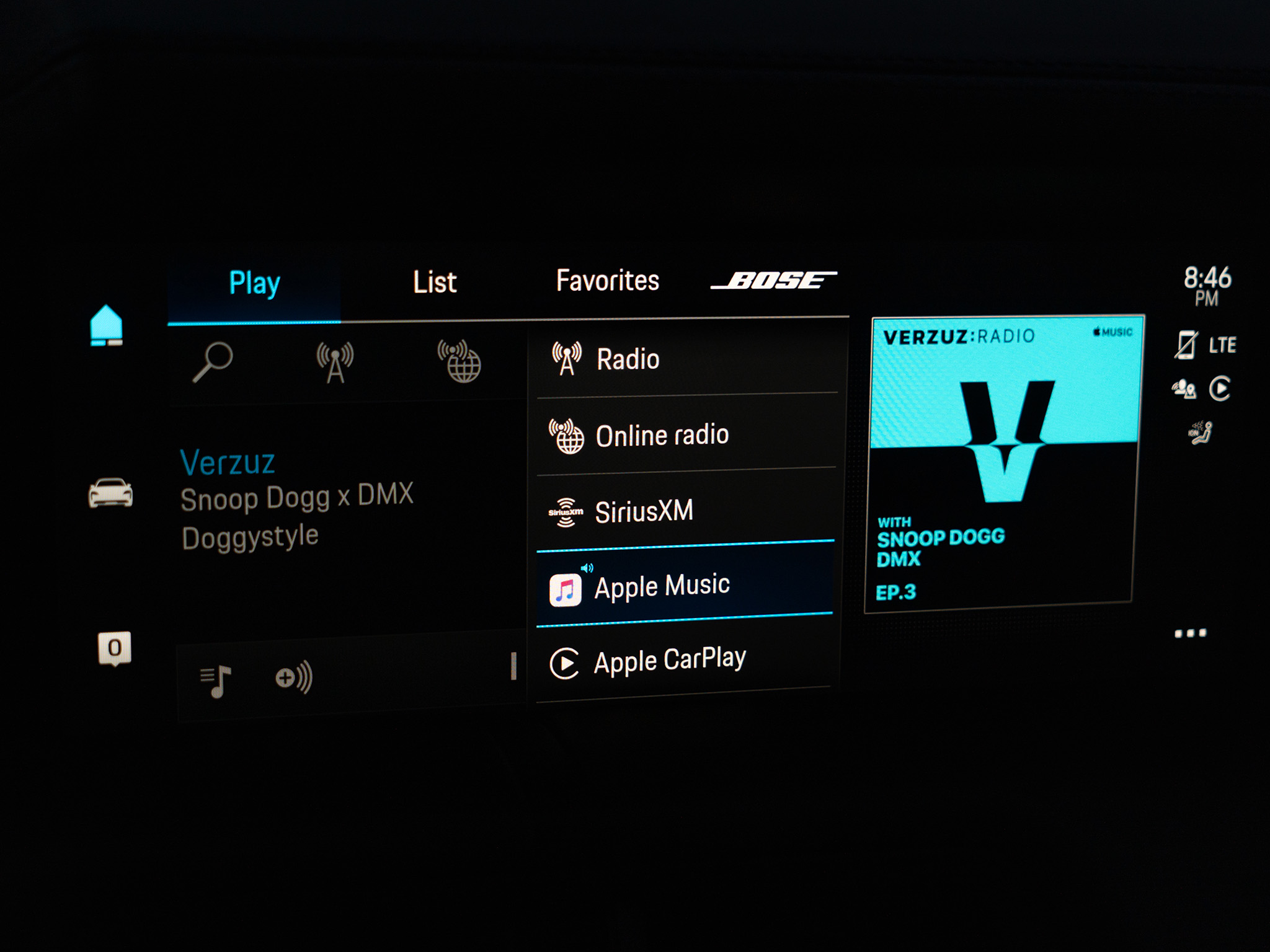
The entirety of Apple Music's 60-million strong library is available.
The UI is all Porsche, so it has no real resemblance to anything Apple has. Everything from the colors, graphical treatments and fonts bear little to no correlation with what Cupertino usually does. It serves as a constant reminder that Apple is living in Porsche's house, and not the other way around.
The entirety of Apple Music's 60-million strong library is available, and according to Porsche, entirely indexed. That means drivers could ask the Voice Pilot to play anything the service offers. It's just unfortunate that wasn't my experience.
For reasons I (and Porsche reps) couldn't ascertain, voice commands for songs, artists and playlists all yielded an error message in response. I'm partly chalking it up to a technical issue that may have been specific to my test vehicle, since the feature appears to work on other Taycans.
As annoying as that was, I was truly surprised that I could search for music by literally typing it into the onscreen keyboard — while driving. Given how many automakers block that when their cars are moving, this was an unexpected feature for an all-electric ride that can go up to 162 mph.
One of the challenges in using the keyboard is the limited real estate available in search results. Because the screen can only display a short list of songs or artists, you have to keep tapping for additional options to eventually get to what you're looking for. Or you have to be really specific and type out both the artist and song title to narrow it down, adding to the time you have to look at the screen. That's easier to do by voice, though the list would still look the same under that scenario anyway.
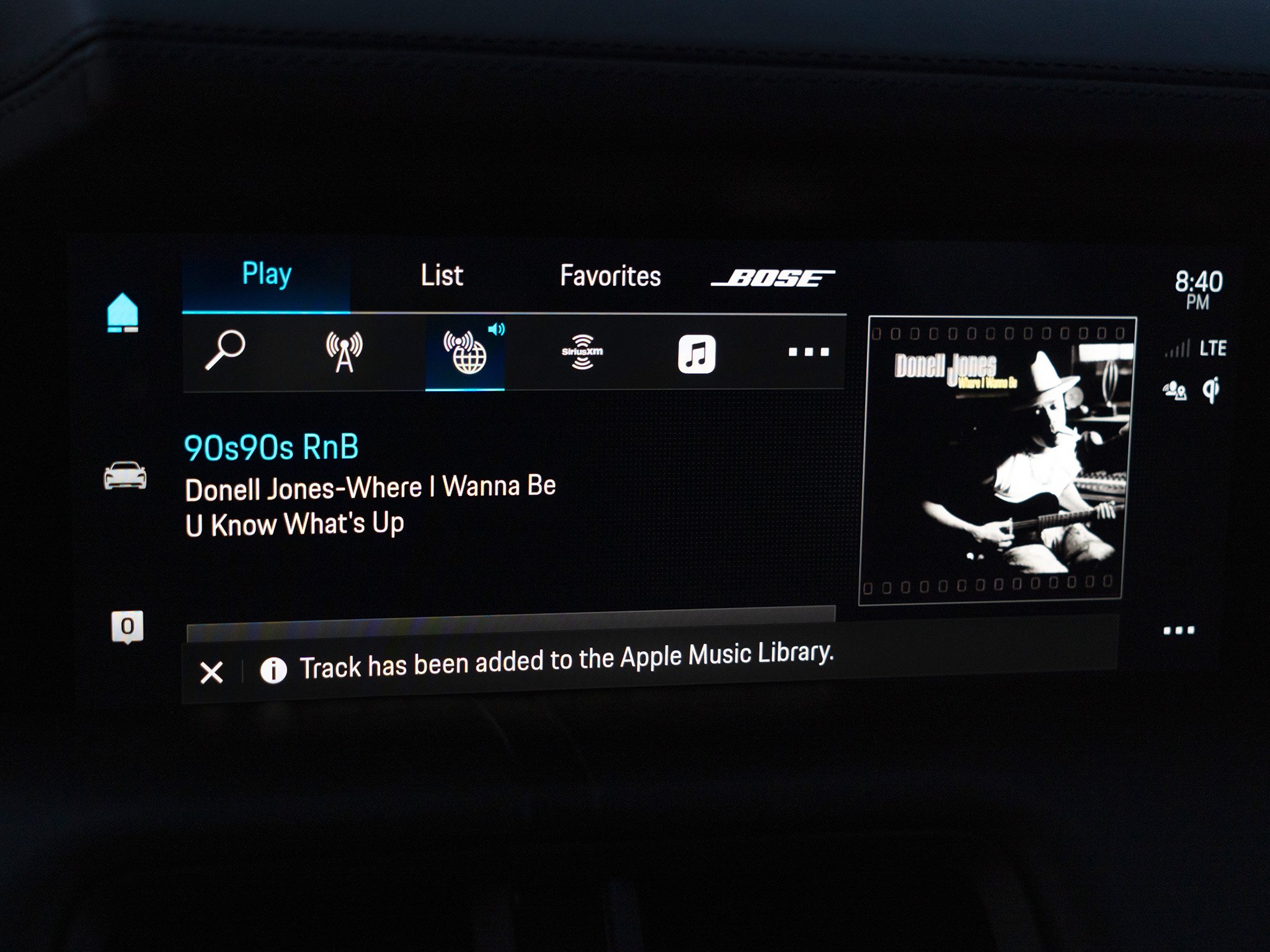
It was easier to add music from an iPhone while away, and then have it load up in the car once the server updated it. Even though the Taycan doesn't support Android Auto, Apple Music subscribers using Android devices can do the same to add music or create playlists.
Despite the tech issues along the way, the integration is fairly natural when the music actually plays. Whether it was Beats 1 radio or accessing and shuffling a playlist, streaming without caring a wit about data limits felt pretty liberating.
Even better was the way Porsche integrates Apple's service into other playback sources. I could come across a track on terrestrial radio and add it to my Favorites on Apple Music. I did the same listening to certain Internet radio stations (remixes aren't always assured), yet couldn't replicate the experience with SiriusXM for reasons that are unclear as of this review.
One thing I didn't like was starting a radio station based on a song or artist. Rather than continue playing the song I was just listening to, it would cut it off and start with something else. Spotify does a better job of that, in my experience.
Using CarPlay instead

Since the PCM only bakes in Apple Music, other iOS apps are left out of the loop. That's where CarPlay compatibility can come in to help out. The best part is that you can run it at the same time as the integrated streaming service — with a catch or two.
First, just to get this to work, you do need a USB-C-to-Lightning cable because the Taycan's USB ports are exclusively of the Type-C variety. Second, holding down the voice button on the steering wheel brings up Siri, except commands will only be relevant to CarPlay — so if you're listening to something from the integrated setup, any requested tunes will play through your phone via CarPlay. That also effectively means you're switching from the car's own data connection to your phone's.
Thing is, this type of hybrid approach may make sense. Porsche has its own built-in navigation map, though it's no match for Waze and Google Maps (I'm not mentioning Apple Maps because it's awful). Same with messaging apps, where better access can be safer for drivers.
What I just described with Siri is also the same when pairing an iPhone to the car via Bluetooth sans CarPlay. Voice commands through Apple's assistant route through the phone, so will only be relevant to features or functions on the device. Porsche's Voice Pilot won't do anything with the phone as it relates to music or navigation.
A sign pointing to the future
Apple Music in the Porsche Taycan: The Bottom Line
As is so often the case in automotive infotainment, luxury vehicles are the guinea pigs for integrations and features that might trickle down to more affordable rides later on. I would argue that's exactly what this is. Apple would love to have its music streaming service baked into more vehicles, which would incentivize people to sign up and pay for it in perpetuity.
When unveiling the Taycan, Porsche called it "the best music experience available." Best? No. Intriguing? Sure. There are more than a few kinks to work out in execution, but the premise and promise are certainly worth pursuing. Naturally, this kind of integration alienates anyone who doesn't use Apple Music, which seems to be of little concern to Porsche because it says an overwhelming majority of its customers are iPhone users.
The idea that apps and services will run directly in the vehicle without the phone's help is all but assured in the next decade of automotive design. While far from perfect in this case, especially since I felt Porsche and Apple were more like roommates than partners at certain moments, some updates and tweaks could fix many of the issues I pointed out.
Assuming both sides commit to that, there is a chance this integration could be an example to follow. If not, then it will be a forgettable footnote that most people wouldn't have even known about.
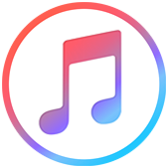
A huge music library on wheels
Porsche and Apple came together to portend what the future could look like when it comes to streaming music in the car without needing a phone.
